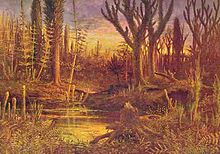User:Thisisamoment/sandbox
Mokupuni Ola Superorganism
[edit]The Mokupuni Ola Superorganism, commonly known as Mu Superorganism or simply Mu, is a colossal landmass located in the Pacific Ocean near Hawaii. It is the largest known superorganism on Earth, spanning approximately 3.44 million square kilometers (37 trillion square feet). It was first discovered by Polynesian voyagers in 850 AD and was initially known as Hawaiki, the supposed original home of the Polynesians, before spreading throughout Polynesia. Its surface is covered in rough terrain, with Mu consisting of the main island Hawaiki in the west and more splintered, scattered islands in the east. Ongoing research by the NOAA (National Oceanic and Atmospheric Administration) and the GSA (Geological Society of America) aims to comprehensively understand the organism, its anatomy, and how it has impacted the world.
History
[edit]It is likely that Mu is not native to Earth; scientists theorize that the appearance of the superorganism comes from extraterrestrial life, with it impacting Earth and releasing a collective of smaller, microscopic organisms onto the planet. Although it is unknown where the organism's original home is, it is hypothesized to be Theia, a planet that is possibly responsible for the creation of the Moon.

The organism would soon adapt to the harsh conditions of the rocky earth. During the Archean Eon,

the superorganism now dubbed Lithogea created a symbiotic relationship with Earth's early geological and biological systems. They soon began to conglomerate themselves, forming the earliest stages of the superorganism. During their accumulation, they developed litho-skin, a rugged rock-like skin made of three layers skin that is rich in materials like silica, calcium carbonate, basalt, hydroxyapatite, and other materials. Along with mineral-rich veins called nutrivines that would deepen themselves to the innards of the earth, managing to reach Earth's underground resources. During the process of connect themselves, specialized cells were made in order to help with chemosynthesis in order to extract inorganic chemical reactions and photosynthesis in order to produce energy. In the Proterozoic Eon, Lithogea starts developing into larger, more complex structures, with them deepening themselves into the earth's crust, manipulating the tectonic plates, and developing intelligence in order to not go too deep. These formations would soon develop into lithopods, stone-like limbs made of more developed litho-skin, predominantly composed of clay minerals that help absorb nutrients and ion exchange, chitin for protection and stabilization, and iron oxides, specifically ferric oxide and black iron oxide. In the Cambrian Period, Lithogea diversified itself across the Iapetus Ocean as a more established superorganism coexisting with the evolving marine life, and in the Devonian Period, plants and animals began to colonize and flourish on the land as Lithogea extended its terrestrial influence, interacting with the early plant life.


During the Permian, an event known as the Lithogean Mass Sinking occurred, a time when Lithogea started to sink slowly, resulting in the mass extinctions of various unknown species and the disappearance of Lithogea until the Pleistocene as the organism starts to rise as small islands during the spread of the hominids, contributing to early myths and legends.

